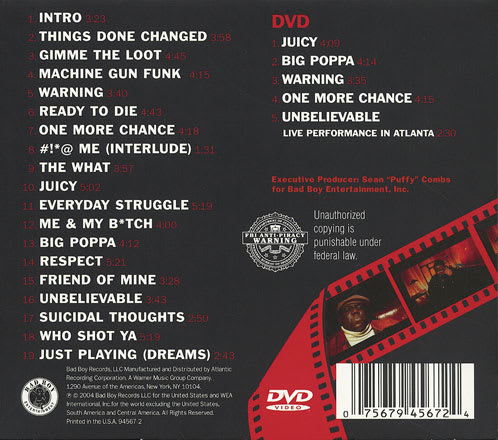The Notorious B I G Ready To Die Zip Viperial Music
• ' Released: August 9, 1994 • ' Released: December 30, 1994 • 'Warning' Released: February 1995 • ' Released: June 6, 1995 Ready to Die is the debut by American rapper, released on September 13, 1994,. The album features production by Bad Boy founder,,,, and, among others. It was recorded from 1993 to 1994 at and in. The partly autobiographical album tells the story of the rapper's experiences as a young criminal, and was the only studio album released during his lifetime, as he was murdered sixteen days before the release of his second album in 1997. Ready to Die was released to critical acclaim and became a commercial success, achieving Gold certification. In 1995, it was certified double platinum by the (RIAA), and has since reached a certified 6x with sales.
It was significant for revitalizing the scene, amid 's commercial dominance. The album's second single ' was nominated for a at the. Ready to Die has been regarded by many critics as one of the greatest hip hop albums, as well as one of the best albums of all time. Contents • • • • • • • • • • • • • • • • • • • Background and recording [ ] The album was recorded in (mainly at ) in two stages between 1993 and 1994. In 1994, Biggie was 21 years old going on 22 when he recorded the album. In 1993, Biggie was signed to the label.
Biggie started recording his debut album in New York, after making numerous guest appearances among his label-mates' singles during the previous year. The first tracks recorded include the album's darker, less radio-friendly content (including 'Ready to Die,' 'Gimme the Loot' and 'Things Done Changed'). In these sessions, magazine describe an 'inexperienced, higher-pitched' Biggie sounding 'hungry and paranoid'. When executive producer was fired from Uptown, Biggie's career hung in limbo, as the album was only partially completed. After a brief period in, Biggie returned to the studio the following year on Combs' new label possessing 'a smoother, more confident vocal tone' and completed the album. In this stage, the more commercial-sounding tracks of the album were recorded, including the album's singles. Between the two stages, XXL writes that Biggie moved from writing his lyrics in notebooks to them from memory.
The album was released with a cover depicting an infant resembling the artist, though sporting an, which pertains to the album's concept of the artist's life from birth to his death. It has been listed as among the best album covers in hip hop. Lawsuits and sample removal [ ] On March 24, 2006, and won a federal lawsuit against for copyright infringement, with a jury deciding that Combs and Bad Boy had illegally used samples for the production of the songs 'Ready to Die', 'Machine Gun Funk', and 'Gimme the Loot'.

Ready to Die is the debut studio album by American rapper The Notorious B.I.G., released on September 13, 1994, by Bad Boy and Arista Records. The album features production by Bad Boy founder Sean 'Puffy' Combs, Easy Mo Bee, Chucky Thompson, DJ Premier, and Lord Finesse, among others.
The jury awarded $4.2 million in punitive and direct damages to the two plaintiffs, and federal judge enacted an immediate sales ban on the album and tracks in question. Ex sense pro v4 2 22 17. On appeal, the found the damages unconstitutionally high and in violation of and remanded the case, at which point Campbell reduced them by $2.8 million; however, the verdict was upheld. All versions of the album released since the lawsuit are without the disputed samples. Although a issue, Combs and Bad Boy never raised the legal concept of the fair use doctrine in their defense. This decision was questioned by some legal experts: Anthony Falzone of the at criticized Combs and Bad Boy for not defending the legality of sampling and suggested that they might have refused to raise such a defense because they feared it could later imperil their control over their own music.
On April 2, 2014, of filed a multimillion-dollar copyright infringement suit against Combs, Bad Boy Records, and the estate of the late for copyright infringement, alleging that his song ' was illegally sampled in the production of the song 'The What'. The estate countersued in turn, claiming the sample as used was short, adapted, and supplemented, and thus subject to fair use, a legal tactic not pursued previously. Composition [ ] Production [ ] The production on the album was mainly handled by and The Hitmen. Coker of depicted the beats as 'heavy bottomed and slick, but B.I.G.' S rhymes are the showstoppers. The tracks only enhance them, whether it's the live bass driving a menacing undercurrent or [the] use of bluesy guitar and wah-wah feedback' and that the production is used to 'push the rapper to new heights.' The production is mainly -based with the samples varying from the of tracks to the vocals of hip hop songs.
